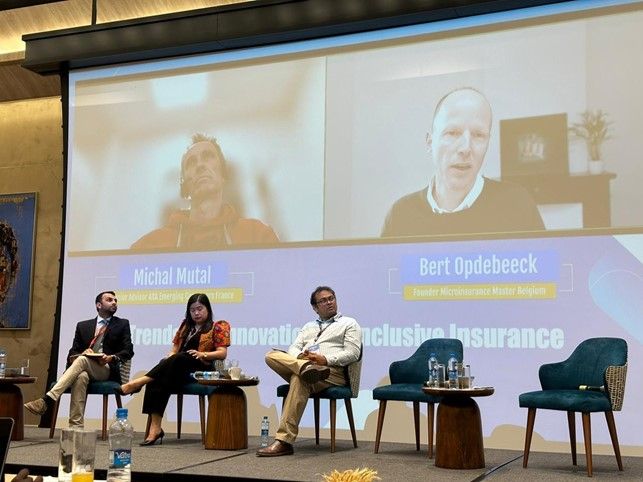Microinsurance innovation: What Zambia can learn from the Philippines
In April 2024, the Microinsurance Technical Advisory Group (TAG) hosted its first-ever conference on insurance in Livingstone, Zambia. Doubling up as the 9th Eastern and Southern Africa Regional Conference on Inclusive Insurance, the event was attended by around 100 insurance and development experts from over 10 countries. Its theme centred on “accelerating the growth of the insurance sector through inclusivity, client-centricity and technology”. While these ingredients are necessary for inclusive insurance to grow, they are also likely to drive innovation in the sector. Innovation was a key part of the event’s agenda, with several lessons emerging from Africa and Asia during a dedicated panel.
A common point among the panellists was the importance of customer-centricity. To date, the most successful microinsurance providers have prioritised customer needs and designed products that offer customers value. Often, this separates solutions that have worked from those that have struggled to scale. The latter is sometimes hampered by focusing on risk identification and claims assessment – the norm in traditional, indemnity-based insurance – or by focusing too much on how technology can be used.

Panel on “Trends in innovation in inclusive insurance” at the 9th Eastern and Southern Africa Regional Conference on Inclusive Insurance. Panellists – seated: Rishi Raithatha (Vark Consulting, UK), Melinda Grace Labao (CARD Pioneer, Philippines) and Agrotosh Mookerjee (Risk Shield, Zambia); on-screen: Michal Matul (AXA Emerging Consumers, France) and Bert Opdebeeck (Microinsurance Master, Belgium).
While digital technology has enabled many microinsurance services to scale, few of these have relied on high-tech solutions. For instance, blockchain’s use in microinsurance remains a key discussion point in the industry. Despite some good ideas, blockchain has not yet presented clear use cases. Most individuals that microinsurance providers are looking to target are still less than likely to be using smartphones. There remains a role for 2G mobile technology to play. For smartphone users, using existing communication channels, such as WhatsApp and Facebook Messenger, offer a way to reach customers. However, this could be a challenge in regions where connectivity is limited and data costs are high (or where cheap data for social media is not available).
Both customer-centricity and technology have driven the success of microinsurance in the Philippines. Pioneer Insurance partnered with CARD, a microfinance institution, in 2008 and had reached over 23 million customers as of December 2023. In addition to a customer-focused solution and using existing technology platforms to reach users, Pioneer’s success can be attributed to its partnership with CARD, which has been based on transparency and open communication. Both companies’ values are aligned too, especially in providing value to their agents, employees and customers.
The key lesson for the predominantly Zambian audience was that Pioneer’s success in the Philippines offers a possible replicable strategy. The partnerships in this example prioritise the importance of shared goals. This offers any collaboration a chance of succeeding. While meeting a shared goal is important, the other lesson from the Philippines is the longevity involved: building a sustainable microinsurance business requires a long-term commitment. Early investments in infrastructure and agent training in the Philippines have led to significant growth over time.
“…only approximately 1 in 10 people have any insurance in a world of rising risks[.] [I]nnovative product design and distribution will be instrumental to the sector’s growth along with more efficient and scalable processes like claims payment.” The Landscape of Microinsurance 2023 |
The challenge for Zambia, like much of Sub-Saharan Africa, is making health insurance accessible for low-income customers. The high cost of comprehensive healthcare makes it unaffordable to many. Although basic hospital cash insurance plans can be designed to be affordable, distribution can be a significant challenge to reach the last mile. Basic mobile phones should be used to offer primary healthcare through telemedicine. And while smartphone penetration continues to grow in Sub-Saharan Africa, health microinsurance providers should focus on using channels such as WhatsApp to provide customers with an enhanced customer experience. Such an approach can improve health-seeking behaviour among the population, while making healthcare more accessible.
Ultimately, microinsurance innovation can be successful when it focuses on creating value for the customer. Existing digital tools or technology platforms can offer customers familiarity with a known experience and win their trust, further lowering the barrier to product uptake. According to the 2023 Landscape of Microinsurance, innovation in product design and distribution is seen as key to the microinsurance sector’s growth. For this, the industry needs more countries to follow in the footsteps of the Philippines by providing customers with assistance in their time of need.